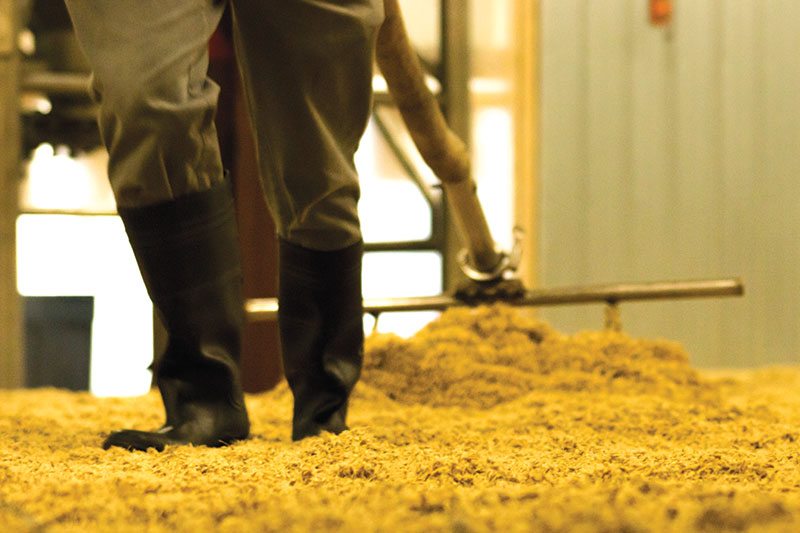Your beer’s second most important ingredient
by Peggy Faye Brown | Photography by Heidi Sawyer
Where is the malt in your Maine craft beer produced? A few years ago, the answer would have been “somewhere else.” Now, thanks to a Mainer with a lot of perseverance, your local brew’s second most important ingredient comes right from our own region.
Art of floor malting revived
Malting is the process of converting raw grains into malt. The process begins by steeping raw grain in water. As the grain begins to germinate, the grain’s chemistry changes and frees up starches that become fermentable sugars. How is this done? In very large processing centers in other parts of the country and around the world, the technique is mechanized. In Lisbon Falls, Maine, the process is done the old-fashioned way, by “floor malting.”
Using 10,000 pounds of raw grain per production run, the Blue Ox crew prepares for the germination process. They blend art and science to properly tend the time and temperature needed to produce the desired product. One of the challenges is to reach the color and flavor requested by the brewers.
After two days of soaking in enormous steep tanks, each of which hold 5,000 pounds of barley, wheat or rye, the grains are spread (“cast”) out for floor malting onto a 2,000 sq. ft. concrete floor. Rakes and shovels are used to manually rotate, or turn, the grain every 5 to 6 hours. Turning regulates the temperature and prevents the rootlets from matting together. After several days of being turned, the grains are put into an enormous custom designed kiln, which acts as a dehydrator. After this, the rootlets are removed and the malt is cleaned. The malt is then bagged and shipped to brewers.
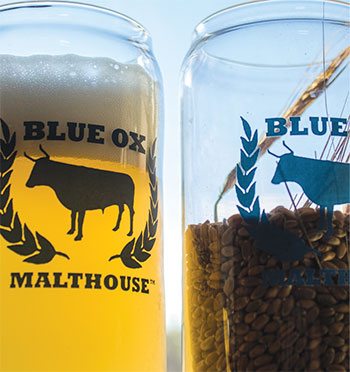

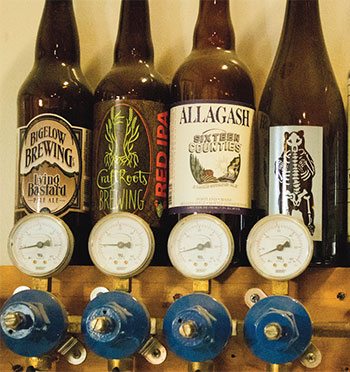
Malt matters
Joel Alex has created another spoke in the wheel of collaboration connecting Maine agriculture to craft brewing. Malt is actually produced right at the Blue Ox Malthouse in Lisbon Falls. According to Alex, “Malt is the silent workhorse of beer. It provides the enzymes, starches, and nutrients that ultimately feed the yeast, provide the color and clarity (or haze) that gives us our first impression, and provides the foundation on which flavors can be built, expressed and highlighted.”
Maltster and founder Alex would like to thank local brewers for using his malt. Their patronage provides income for his employees and the farmers who produce the barley, rye and wheat which is processed at Blue Ox Malthouse. Blue Ox sources most of the grain from Aroostook County farmers, supplementing when needed with regional grains from farmers in Vermont and Quebec.
Blue Ox Malthouse creates five core styles of malt: pale base, hard red wheat, Vye-enna, Munich, and Organic pale base. One of the missions of the company, according to Alex, is to “combine traditional methods and modern technologies to create unique malts that highlight Maine growers and what we can do right here in our state.”
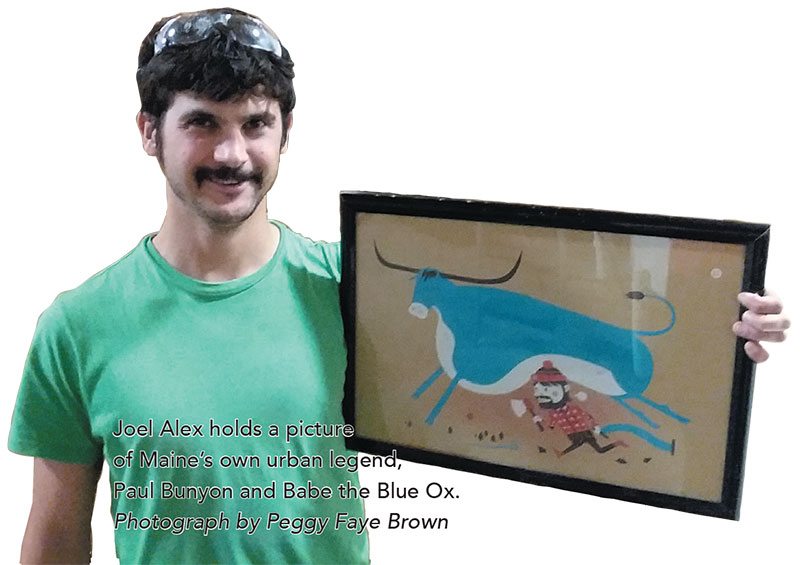
Germinating a great idea
While contemplating grad school to study rural economic development, a chance conversation with a craft brewer in 2012 caused Joel Alex to wonder if malt could be created in Maine. With a background in the fields of environmental science, education, and land conservation, this Colby College graduate began his research and figured out how to make it happen, even seeking information from the 1908 book, Practical Floor Malting, by Hugh Lancaster.
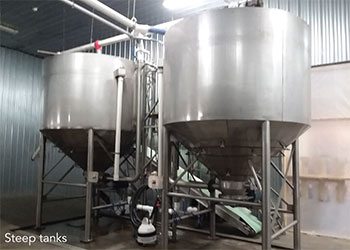 A few experimental batches were created using commercial kitchens while Alex searched from Biddeford to Caribou for a facility. Malting equipment was only made for large-scale operations, so Alex custom-designed what he needed. Davis Brothers of Chester, Maine, built the two large steep tanks and Nyle Systems, of Brewer, made the kiln. Prior to 2015, Maine grains were exported to Canada to be malted, and then distributed out of New York. Now the process happens right here at Blue Ox Malthouse, the only dedicated malthouse in Maine, and the largest floor malting facility in North America. Alex serves on the Board of Directors of The North American Craft Maltsters Guild, a member organization of craft malthouses seeking to revive the industry.
A few experimental batches were created using commercial kitchens while Alex searched from Biddeford to Caribou for a facility. Malting equipment was only made for large-scale operations, so Alex custom-designed what he needed. Davis Brothers of Chester, Maine, built the two large steep tanks and Nyle Systems, of Brewer, made the kiln. Prior to 2015, Maine grains were exported to Canada to be malted, and then distributed out of New York. Now the process happens right here at Blue Ox Malthouse, the only dedicated malthouse in Maine, and the largest floor malting facility in North America. Alex serves on the Board of Directors of The North American Craft Maltsters Guild, a member organization of craft malthouses seeking to revive the industry.
Raise a glass to the future
While the grain on the malting floor sprouts roots, Blue Ox Malthouse is also sprouting great things for our greater LA community as a source of jobs and high-quality local product for craft brewers. Blue Ox malt also supplies local bakers who use it to create flour.
Although the days of using oxen to harvest are gone, their logo gives credit to agricultural history and the company’s roots in Maine. One cannot miss the Paul Bunyan statue in Bangor, and most people recall his blue ox named Babe.
Blue Ox Malthouse has proven that agricultural endeavors can be accomplished locally through encouragement and education. Just as great beers are the right blend of flavors, Blue Ox Malthouse is a great blend of the past (art of malting), present (technology) and future (educating others). The production in Lisbon Falls lends itself nicely to the University of Maine’s research projects on grains. UMaine has conducted variety trials, and analyzed data comparing LA’s malts to those from other sites, to identify which grains are best suited to different regions.
More information can be viewed at:
https://extension.umaine.edu/grains-oilseeds/
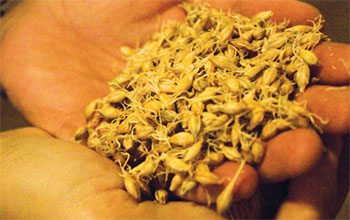 Joel Alex would like local brewers to be recognized for using local malt, since this impacts the farmers and workers in local communities in a positive way. Visit the website www.blueoxmalthouse.com to see the list of brewers and the next time you enjoy one of these local brews, raise a glass in thanks to the brewery for using local malt from Lisbon Falls.
Joel Alex would like local brewers to be recognized for using local malt, since this impacts the farmers and workers in local communities in a positive way. Visit the website www.blueoxmalthouse.com to see the list of brewers and the next time you enjoy one of these local brews, raise a glass in thanks to the brewery for using local malt from Lisbon Falls.
Blue Ox Malthouse
41 Capital Avenue, Lisbon Falls
BlueOxMalthouse.com
Peggy enjoys the art of writing, whether typed or handwritten in cursive. She brainstorms and daydreams whenever possible while working and commuting. Her first memoir was just published in Goose River Anthology 2018; her first work of fiction appeared in the 2017 edition.
-
She enjoys writing pieces with a purpose: to commemorate the past and encourage the future.

